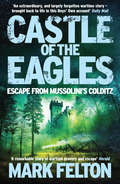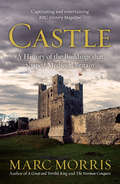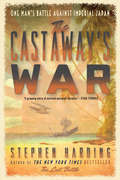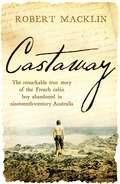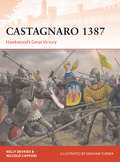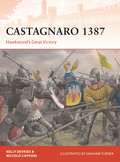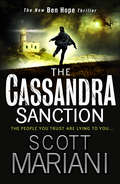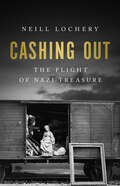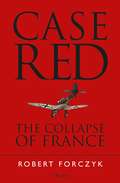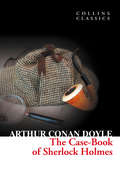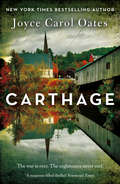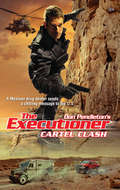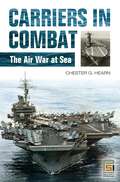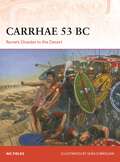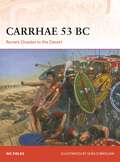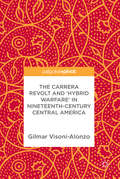- Table View
- List View
Castle of the Eagles: Escape from Mussolini’s Colditz
by Mark FeltonHigh in the Tuscan hills above Florence, an elaborate medieval castle, converted to a POW camp on Mussolini’s personal orders, holds one of the most illustrious groups of prisoners in the history of warfare. The dozen or so British and Commonwealth senior officers includes three knights of the realm and two VCs. The youngest of them is 48, the oldest 63. One is missing a hand and an eye. Another suffers with a gammy hip. Against insuperable odds, these extraordinary middle-aged POWs plan a series of daring escape attempts, culminating in a complex tunnel deep beneath the castle. One rainswept night in March 1943, six men will burst from the earth beyond the castle’s curtain wall and slip away. By assorted means, the three Brits, two New Zealanders and a half-Belgian aristocrat will attempt to make it to neutral Switzerland, over 200 miles away.
Castle: A History of the Buildings that Shaped Medieval Britain (Paper Toy Ser.)
by Marc MorrisBeginning with their introduction in the eleventh century, and ending with their widespread abandonment in the seventeenth, Marc Morris explores many of the country’s most famous castles, as well as some spectacular lesser-known examples. At times this is an epic tale, driven by characters like William the Conqueror, King John and Edward I, full of sieges and conquest on an awesome scale. But it is also by turns an intimate story of less eminent individuals, whose adventures, struggles and ambitions were reflected in the fortified residences they constructed. Be it ever so grand or ever so humble, a castle was first and foremost a home.To understand castles – who built them, who lived in them, and why – is to understand the forces that shaped medieval Britain.
The Castaway's War: One Man's Battle against Imperial Japan
by Stephen HardingShipwrecked on a South Pacific island, a young US Navy lieutenant waged a one-man war against the JapaneseIn the early hours of July 5, 1943, the destroyer USS Strong was hit by a Japanese torpedo. The powerful weapon broke the destroyer's back, killed dozens of sailors, and sparked raging fires. While accompanying ships were able to take off most of Strong's surviving crewmembers, scores went into the ocean as the once-proud warship sank beneath the waves--and a young officer's harrowing story of survival began.Lieutenant Hugh Barr Miller, a pre-war football star at the University of Alabama, went into the water as the vessel sank. Severely injured, Miller and several others survived three days at sea and eventually landed on a Japanese-occupied island. The survivors found fresh water and a few coconuts, but Miller, suffering from internal injuries and believing he was on the verge of death, ordered the others to go on without him. They reluctantly did do, believing, as Miller did, that he would be dead within hours.But Miller didn't die, and his health improved enough for him to begin searching for food. He also found the enemy--Japanese forces patrolling the island. Miller was determined to survive, and so launched a one-man war against the island's occupiers.Based on official American and Japanese histories, personal memoirs, and the author's exclusive interviews with many of the story's key participants, The Castaway's War is a rousing story of naval combat, bravery, and determination.
Castaway: The remarkable true story of the French cabin boy abandoned in nineteenth-century Australia
by Robert Macklin'A truly remarkable account drawing upon a version Pelletier gave when he eventually returned to his native France and also on anthropological studies of the Daintree people.' Piers Akerman, Daily Telegraph, Sydney 'An unforgettable tale of transformation and upheaval.'Stuart McLean, Daily Telegraph, SydneyA young boy abandoned in an alien landscape thousands of miles from home is adopted by local people and becomes one of them, welcomed into their community, marrying a wife and raising a child. After seventeen years, he is stolen back to his 'real' life, where he has another family, but dreams constantly of what he has left behind.This is the remarkable true story of a French cabin boy Narcisse Pelletier who, after disembarking from his ship the Saint-Paul with the rest of its crew in search of drinking water, found himself separated from his shipmates and in the end abandoned on the north coast of Queensland, Australia. Narcisse was adopted by an Aboriginal group who welcomed him as one of their own for seventeen years, during which time he had a family of his own. In 1875, though, he was kidnapped by the brig John Bell and was returned eventually to his family in Saint-Gilles, France, where he became a lighthouse keeper. Robert Macklin makes skilful use of Narcisse's own memoir Chez les sauvages along with new research to tell this extraordinary story.Robert is a Queenslander so knows the terrain and the people of the area in which Narcisse was left behind. Through Noel Pearson's Cape York Institute, he has arranged to meet descendants of the people who took the French cabin boy in and who know the stories of his time in Australia. Robert has also had access to a great deal of material on the early history of the Cape through the Australian National Library. He has drawn on the significant resources of the Australian Institute of Aboriginal and Torres Strait Islander Studies (AIATSIS) in Canberra on Aboriginal culture and history in Queensland and the Cape. In addition, he has made use of Narcisse Pelletier's own writings, including his account of his time in Australia, as well as several contemporaneous accounts of the Kennedy expedition to the area, including one from a member of the party. The author has made several trips to Cape York and one to Saint-Gilles and Saint-Nazaire in France.
Castagnaro 1387: Hawkwood’s Great Victory (Campaign)
by Kelly DeVries Niccolò CapponiThe battle of Castagnaro, fought on 11 March 1387 between the Veronese and the Paduans, is one of the most famous Italian medieval conflicts in the English-speaking world. This is thanks in no small part to the exploits of the renowned English mercenary (or condottiero) captain, Sir John Hawkwood. Commanding the Paduan army, he led them to a stunning victory.This new study challenges the conventional story of the battle, relocating it to the other side of the Adige River, and showing that Hawkwood was no mere disciple of his previous commander, the Black Prince–he was a highly talented and intelligent general in his own right. Using specially commissioned full-colour artwork, this fascinating book shows how Hawkwood used his own acumen, and the training, skills, and discipline of his very experienced condottieri, to defeat his opponents at Castagnaro.
Castagnaro 1387: Hawkwood’s Great Victory (Campaign #337)
by Kelly DeVries Niccolò CapponiThe battle of Castagnaro, fought on 11 March 1387 between the Veronese and the Paduans, is one of the most famous Italian medieval conflicts in the English-speaking world. This is thanks in no small part to the exploits of the renowned English mercenary (or condottiero) captain, Sir John Hawkwood. Commanding the Paduan army, he led them to a stunning victory.This new study challenges the conventional story of the battle, relocating it to the other side of the Adige River, and showing that Hawkwood was no mere disciple of his previous commander, the Black Prince–he was a highly talented and intelligent general in his own right. Using specially commissioned full-colour artwork, this fascinating book shows how Hawkwood used his own acumen, and the training, skills, and discipline of his very experienced condottieri, to defeat his opponents at Castagnaro.
The Cassandra Sanction (Ben Hope #12)
by Scott MarianiTHE MOST SHOCKING ADVENTURE YET FROM THE #1 BESTSELLING AUTHOR ‘Deadly conspiracies, bone-crunching action and a tormented hero with a heart . . . packs a real punch’ Andy McDermott
Cashing Out: The Flight of Nazi Treasure, 1945–1948
by Neill LocheryWhen Nazis looked to flee Europe with stolen art, gems, and gold in tow, certain &“neutral&” countries were all too willing to assist them. By the end of January 1945, it was clear to Germany that the war was lost. The Third Reich was in freefall, and its leaders, apart from those clustered around Hitler in his Berlin bunker, sought to abscond before they were besieged. But they wanted to take their wealth with them. Their escape routes were diverse: Sweden and Switzerland boasted proximity, banking, and industrial closeness, while Spain and Portugal offered an inviting Atlantic coastline and shipping routes to South America. And in various ways, each of these so-called neutral nations welcomed the Nazi escapees, along with the clandestine wealth they carried. Cashing Out tells the riveting history of the race to intercept the stolen assets before they disappeared, and before the will to punish Germany was replaced by the political considerations of the fast-approaching Cold War. Bestselling author Neill Lochery here brilliantly recounts the flight of the Nazi-looted riches—the last great escape of World War II—and the Allied quest for justice.
Case White: The Invasion of Poland 1939
by Robert ForczykThe German invasion of Poland on 1 September, 1939, designated as Fall Weiss (Case White), was the event that sparked the outbreak of World War II in Europe. The campaign has widely been described as a textbook example of Blitzkrieg, but it was actually a fairly conventional campaign as the Wehrmacht was still learning how to use its new Panzers and dive-bombers. The Polish military is often misrepresented as hopelessly obsolete and outclassed by the Wehrmacht, when in fact it was well-equipped with modern weapons and armour. Indeed, the Polish possessed more tanks than the British and had cracked the German Enigma machine cipher. Though the combined assault from Germany and the Soviet Union defeated Poland, it could not crush the Polish fighting spirit and thousands of soldiers and airmen escaped to fight on other fronts. The result of Case White was a brutal occupation, as Polish Slavs found themselves marginalized and later eliminated, paving the way for Hitler's vision of Lebensraum (living space) and his later betrayal and invasion of the Soviet Union in 1941. Using a wide array of sources, Robert Forczyk challenges the myths of Case White to tell the full story of the invasion that sparked history's greatest conflict.
Case White: The Invasion of Poland 1939
by Robert ForczykThe German invasion of Poland on 1 September, 1939, designated as Fall Weiss (Case White), was the event that sparked the outbreak of World War II in Europe. The campaign has widely been described as a textbook example of Blitzkrieg, but it was actually a fairly conventional campaign as the Wehrmacht was still learning how to use its new Panzers and dive-bombers. The Polish military is often misrepresented as hopelessly obsolete and outclassed by the Wehrmacht, when in fact it was well-equipped with modern weapons and armour. Indeed, the Polish possessed more tanks than the British and had cracked the German Enigma machine cipher. Though the combined assault from Germany and the Soviet Union defeated Poland, it could not crush the Polish fighting spirit and thousands of soldiers and airmen escaped to fight on other fronts. The result of Case White was a brutal occupation, as Polish Slavs found themselves marginalized and later eliminated, paving the way for Hitler's vision of Lebensraum (living space) and his later betrayal and invasion of the Soviet Union in 1941. Using a wide array of sources, Robert Forczyk challenges the myths of Case White to tell the full story of the invasion that sparked history's greatest conflict.
Case Red: The Collapse of France
by Robert ForczykEven after the legendary evacuation from Dunkirk in June 1940 there were still large British formations fighting the Germans alongside their French allies. After mounting a vigorous counterattack at Abbeville and then conducting a tough defence along the Somme, the British were forced to conduct a second evacuation from the ports of Le Havre, Cherbourg, Brest and St Nazaire. While France was in its death throes, politicians and soldiers debated what to do – flee to England or North Africa, or to seek an armistice.Case Red captures the drama of the final three weeks of military operations in France in June 1940, and explains the great impact it had on the course of relations between Britain and France during the remainder of the war. It also addresses the military, political and human drama of France's collapse in June 1940, and how the windfall of captured military equipment, fuel and industrial resources enhanced the Third Reich's ability to attack its next foe – the Soviet Union.
Case Red: The Collapse Of France
by Robert ForczykEven after the legendary evacuation from Dunkirk in June 1940 there were still large British formations fighting the Germans alongside their French allies. After mounting a vigorous counterattack at Abbeville and then conducting a tough defence along the Somme, the British were forced to conduct a second evacuation from the ports of Le Havre, Cherbourg, Brest and St Nazaire. While France was in its death throes, politicians and soldiers debated what to do – flee to England or North Africa, or to seek an armistice.Case Red captures the drama of the final three weeks of military operations in France in June 1940, and explains the great impact it had on the course of relations between Britain and France during the remainder of the war. It also addresses the military, political and human drama of France's collapse in June 1940, and how the windfall of captured military equipment, fuel and industrial resources enhanced the Third Reich's ability to attack its next foe – the Soviet Union.
A Case of Knives (Abacus Bks.)
by Candia McWilliamLucas Salik is a heart surgeon, renowned for performing bold experiments on other people's hearts. Ostensibly chilly, he harbours a secret obsession for his reckless and charismatic friend Hal. When Hal announces his intention to find a wife, Lucas is forced to carry out his most complex operation yet: to engineer the marriage, setting it on a perilous path to failure. But just as things appear to be working out, Lucas starts receiving ominous letters that threaten to jeopardize his intentions, his career - and his life.
The Case of Edith Cavell: A Study Of The Rights Of Non-combatants (The World At War)
by James BeckA Study of the Rights of Non-Combatants. A title by James Montgomery Beck who was a United States Solicitor General, author, and member of the United States House of Representatives from Pennsylvania. In 1900 he was appointed Assistant to the Attorney General and served until 1903. In 1914 he was elected a bencher of Gray's Inn, to argue a case for the U.S. before the Privy Council. No foreign barrister in 600 years had been permitted to do so before. In 1921 he was nominated by Warren G. Harding to be the Solicitor General. Beck served until his resignation in 1925. He was elected in 1927 as Congressional Representative from Pennsylvania, filling the vacancy caused by the resignation of James M. Hazlett. (Excerpt from Google)
The Case-Book of Sherlock Holmes (Collins Classics #115)
by Sir Arthur Conan DoyleHarperCollins is proud to present its new range of best-loved, essential classics.
Cartoons of World War II
by Tony HusbandIn peacetime cartoonists are a diverse collection of individuals with their own styles and projects, but when the trumpets of war blow it is like unleashing the dogs of war. Hitler, Stalin, Churchill, Roosevelt and Mussolini were a gift for them and, as this collection shows, one they weren't about to turn down. This book shows that humour was one of the key weapons of war, with countries using cartoons to demoralise their opponents and maintain morale. Each country had its own style: the British liked understatement, showing people drinking cups of tea while bombs fell, whilst the Germans chose Churchill serving up a cocktail of blood, sweat and tears to an emaciated and sickly British lion. Showcasing the very best cartoons from Britain, the USA, Germany, Russia plus the work of all of WWII's greatest cartoonists, including Bill Mauldin, Fougasse, Emett, David Low and Graham Laidler (Pont), this book is guaranteed to make you laugh.
The Carthaginians 6th–2nd Century BC (Elite #201)
by Giuseppe Rava Andrea Salimbeti Raffaele D’AmatoCarthage, the port-city in Tunisia first settled by Phoenicians from Tyre, grew to extend a competitive maritime trading empire all over the Western Mediterranean and beyond, increasingly defended by the best navy of the period. In the 6th century BC this came into confrontation with Greek colonists in Sicily, starting major wars that lasted through the 5th and 4th centuries, and involved much interaction with different Greek forces. During the 3rd century Carthage first clashed with Roman armies, and in the course of three wars that raged over Spain, Sicily and Italy the Romans suffered the greatest defeats in their early history at the hands of Hamilcar, Hannibal and Hasdrubal Barca, leading multinational armies of North Africans and Europeans.
The Carthaginians 6th–2nd Century BC (Elite #201)
by Giuseppe Rava Andrea Salimbeti Raffaele D’AmatoCarthage, the port-city in Tunisia first settled by Phoenicians from Tyre, grew to extend a competitive maritime trading empire all over the Western Mediterranean and beyond, increasingly defended by the best navy of the period. In the 6th century BC this came into confrontation with Greek colonists in Sicily, starting major wars that lasted through the 5th and 4th centuries, and involved much interaction with different Greek forces. During the 3rd century Carthage first clashed with Roman armies, and in the course of three wars that raged over Spain, Sicily and Italy the Romans suffered the greatest defeats in their early history at the hands of Hamilcar, Hannibal and Hasdrubal Barca, leading multinational armies of North Africans and Europeans.
Carthage: A Novel
by Joyce Carol OatesA young girl’s disappearance rocks a community and a family, in this stirring examination of grief, faith, justice and the atrocities of war, from literary legend Joyce Carol Oates.
Cartel Clash
by Don PendletonTensions are high after a powerful Mexican drug cartel kills an undercover DEA agent in a declaration of war against the United States. A shipment of missiles is bound for the region, and Washington's hands are tied with red tape.
Carriers in Combat: The Air War at Sea (Praeger Security International)
by Chester G. HearnSince World War II, there have been no engagements between carrier air groups, but flattops have been prominent and essential in every war, skirmish, or terrorist act that could be struck from planes at sea. Carriers have political boundaries. They range at will with planes that can be refueled in the air to strike targets thousands of miles inland. From the improvised wooden platforms of the early 20th century to today's nuclear-powered supercarriers, Hearn explores how combat experience of key individuals drove the development, technology, and tactics of carriers in the world's navies.In the early 20th century, during the days of the dreadnaughts, innovators in Europe and North America began to fly contraptions made from wood, canvas, wire, and a small combustion engine. Naval officers soon wondered whether these rickety bi-planes could be launched from the deck of a surface vessel. Trials began from jury-rigged wooden platforms built upon the decks of colliers. The experiments stimulated enough interest for the navies of the world to begin building better aircraft and better aircraft carriers. The novelty of a ship that could carry its own airstrip anywhere on the world's oceans caught fire in the 1920s and helped induce a new arms race. While the rest of the world viewed carriers as defensive weapons, Japan focused on offensive capabilities and produced the finest carrier in the world by 1940. World War II would see the carrier emerge as the greatest surface ship afloat. Since then, no war has been fought without them.
Carrhae 53 BC: Rome's Disaster in the Desert (Campaign)
by Nic FieldsExplores the critical battle of Carrhae, a fascinating tale of treachery, tactics, and topography in which Rome experienced one of its most humiliating defeats.The Battle of Carrhae is from a heady moment in Roman history – that of the clever carve-up of power between the 'First Triumvirate' of Caius Iulius Caesar, Cnaeus Pompeius Magnus and Marcus Licinius Crassus (the Roman general who had famously put down the Spartacan revolt). It is a fascinating tale of treachery, tactics, and topography in which Rome experienced one of its most humiliating defeats at the hands of the Parthians, not far from a trade-route town hunkered down on the fringes of the arid wastes of northern Mesopotamia, sending shock waves through the Roman power structure. Join classical historian Dr Nic Fields as he draws out the crucial psychological and political factors (including Crassus' lust for military glory and popular acclaim) that played a key role in this brutal battle. Relive in full detail how, despite being heavily outnumbered, the Parthian general Surena's horsemen completely outmanoeuvered Crassus' legionaries, killing or capturing most of the Roman soldiers. Explore the tactics and techniques of the Parthian horse archers, uncover details of Roman and Parthian equipment and weaponry, and experience the last stand of Publius Crassus, son of Marcus Licinius.
Carrhae 53 BC: Rome's Disaster in the Desert (Campaign)
by Nic FieldsExplores the critical battle of Carrhae, a fascinating tale of treachery, tactics, and topography in which Rome experienced one of its most humiliating defeats.The Battle of Carrhae is from a heady moment in Roman history – that of the clever carve-up of power between the 'First Triumvirate' of Caius Iulius Caesar, Cnaeus Pompeius Magnus and Marcus Licinius Crassus (the Roman general who had famously put down the Spartacan revolt). It is a fascinating tale of treachery, tactics, and topography in which Rome experienced one of its most humiliating defeats at the hands of the Parthians, not far from a trade-route town hunkered down on the fringes of the arid wastes of northern Mesopotamia, sending shock waves through the Roman power structure. Join classical historian Dr Nic Fields as he draws out the crucial psychological and political factors (including Crassus' lust for military glory and popular acclaim) that played a key role in this brutal battle. Relive in full detail how, despite being heavily outnumbered, the Parthian general Surena's horsemen completely outmanoeuvered Crassus' legionaries, killing or capturing most of the Roman soldiers. Explore the tactics and techniques of the Parthian horse archers, uncover details of Roman and Parthian equipment and weaponry, and experience the last stand of Publius Crassus, son of Marcus Licinius.
The Carrera Revolt and 'Hybrid Warfare' in Nineteenth-Century Central America
by Gilmar Visoni-AlonzoThis book provides a novel analysis of the military campaign of Rafael Carrera during the popular insurrection of 1837-1840 in Guatemala. Over the course of three years Carrera, a semi-literate farmer, and his army of peasants established Conservative control over Guatemala and accelerated the disintegration of the Central American Federation. Although Carrera’s rise has been analyzed from a political and socio-economic perspective, the present work shows that Carrera’s vertiginous success is the product of a peculiar and misunderstood approach to warfare that combines guerrilla recruiting practices and rural insurgency logistics with conventional combat tactics and operations. Gilmar Visoni-Alonzo argues that Carrera’s hybrid warfare was made possible because of the conditions created by the militarization of Latin American society following the administrative reforms of the Bourbon monarchy in the late eighteenth century. The concept of hybrid warfare is offered as an alternative model to understand the success of other insurgencies.
